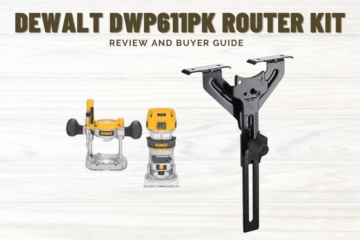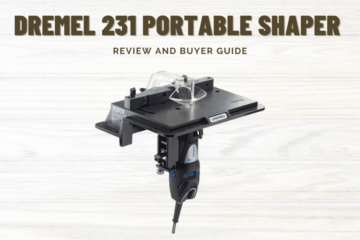Choosing between a shaper and a router is one of the most prominent ongoing debates in the routing community.
Both of these units’ highly efficient design and performance often confuse amateur project makers when buying a machine to go with their projects.
Therefore, to help you make this decision and accurately put an end to the long-going argument between shaper and router, we have written this article for you!
Read ahead to figure out what each machine has to offer and determine which will be the best fit for you!
What are the differences between a shaper and a router?
Often people struggle to differentiate between a shaper and a router and end up spoiling their projects because of this.
Let’s start by erasing this possible element of confusion in any buyer’s mind
Shaper Vs Router
The main difference between a shaper and a router is the type of equipped cutter in the machine and how it is powered. A shaper consists of a spindle, onto which a cutter head slides on. These spindles come in a variety of sizes and offer up to ¼” diameter length.
This large diameter and heavy construction of shapers make them more suitable for heavy-duty and bulkier projects. Inclusively, the motor is finished with a belt to contribute more to the machine’s torque and ultimately the spindle’s power-packed performance.
As the name states, routers make use of router bits and a permanent shank. This shank is attached to the cutter and is responsible for cutting and mounting the unit on tables. Routers are equipped with universal motors that accommodate fast revolutions per minute speed while consuming minimal power.
| Product | Wood Shaper | Router Table |
|---|---|---|
| Speed (RMP) | 10,000 | 20,00 |
| Horse power | 1 to 3 | 1 to 2 |
| Finish | In one pass | At least 3 passes |
| Reversibility | Yes | No |
| Size | Large | Small |
| Noise | Less | A lot of noise |
| Identical cuts | Faster | Slower |
| Cost | Expensive | Less expensive |
What is Wood Shaper?
An induction motor, similar to that found in a table saw, is used in a wood shaper. These work at low speeds yet provide a lot of torque. Because adjusting the speed of a shaper usually entails shifting the belt across a step pulley, they also offer restricted speed possibilities.
Because the shaper’s increased torque enables a larger cutting head, it can eliminate a lot of wood in a single pass, which can save time and money in a busy shop.
However,
Because of the slower pace, cut quality can decrease, though this isn’t always the case, and there’s no reason why you shouldn’t be able to achieve uniformly high-quality cuts with this type of woodworking tool.
Moreover,
Cut dadoes, grooves, and other designs into the internal spaces of material or along the edges with this equipment. A wood shaper can be used to create attractive designs on wood stock, as well as hollowing out for purposes like manufacturing bowls.
Key Features
Speed and motor:
A shaper’s induction motor has a low-speed but high-power rating. Power, defined in Horse Power, can range from 1 to 3 HP or more, though the pace at which the shaper works is probably more essential. A shaper’s speed, calculated in revolutions per minute, is usually approximately 10,000 RPM.
Cutting heads:
Shapers use cutting heads instead of bits, which are used by routers. Because they don’t have a central shank, they can’t be called bits, but the cutter heads provide a comparable role.
Because shapers have slower speeds, their heads are larger, allowing them to carve greater forms and deeper pits. The larger head of the shaper is recommended if you want to complete jobs in a single pass, or at most two passes.
Accuracy:
A larger cutting head may have the drawback of sacrificing some accuracy and precision. If you want to create detailed cuts, the shaper head is probably too big for you.
While most routing projects can be completed with either tool, the shaper is the ideal choice if you value speed and volume over reliability and stability.
Tooling:
Shapers are similar to routers in appearance, but they have significantly more power. Profile cutting with high power is more difficult than with low power. The advantage is that you only need one pass to construct a complex profile.
For the same purpose, a router would need at least three passes. Wide profiles, such as crown moldings and raised panels, are best cut with shaper cutters.
Adaptability:
Shapers can be used with practically any router bit, but not the other way around. Yes, you read that correctly. You may use router bits in your shaper and wave goodbye to your routers with the right adapters.
Reverse:
As is common in carpentry, the grain direction of the wood you’re working with can cause it to split. A shaper, on the other hand, can run backward and easily address this problem. This useful feature, although, is not available in any router in the industry.
Saving time:
However, a router requires three or more passes to create something that a shaper can do in one go. This will save you a lot of time and increase your chances of success.
Heavy machining:
The shaper, not the routers, is the best solution for hard work and big quantities of orders. Although routers are versatile, they are only intended for light-duty tasks.
Always remember to let the tools do the task, not your hand. When it comes to heavy-duty labour, instead of straining a router to its limits, invest in a shaper, which is safer and provides results far faster.
Noise:
Shapers are remarkably quieter than routers, despite their large size. The shapers, on the other hand, have more vibrations than the routers, which is expected given that they are less durable and have a low-rpm belt.
Who should buy this?
Getting a wood shaper would be an excellent idea if you plan to work on higher-caliber assignments such as house flooring or managing large lumbers. It can keep you working the whole day long without tiring you out or forcing you to take a break.
What is Router Table?
A router table will include a motor, a collet, and a tightener, as well as a router bit. The bit will come with both a shaft and a cutter bit; the shaft will be between 14 and 12 inches in length or in different sizes.
To alter the cutting depth horizontally, the table will have a single fence that you must move back and forth. A router table, like a wood shaper, is a huge piece of equipment with a vertical spindle that extends upwards through the table.
Furthermore,
This spindle then powers cutter heads that travel in a circular motion and can be used to carve decorative designs on wood, grooves, dadoes, and even hollow-out wood.
Of the two tools, the router is perhaps the more well-known and widely used. This is due to the fact that it is less expensive than a shaper. It is also more functional, will accommodate more conveniently in a woodworking shop, and can be utilized for a larger range of tasks due to its detail and efficiency.
Moreover,
With a router, you can always make multiple passes to complete greater tasks, but you can’t scale down the cuts made by a huge shaper head.
Key Features
Speed and motor:
The router, despite having a less powerful motor, runs at significantly higher speeds. Motors with 1 to 2 horsepower and speeds up to 20,000 RPM are expected. This increased speed permits for the use of smaller bits, which is one of the reasons behind the router’s precision.
When utilized in a shed or part of the home, this speed makes the router table louder than the shaper, which may result in a screaming noise that makes you unpleasant.
Cutting heads:
Drill bits, instead of cutting heads, are better for the router. First of all, and importantly, the cutting head is easier to identify and less expensive as a result of this. In general, you should be able to find substitute pieces at any DIY or hardware store.
They are cost-effective, albeit higher-quality bits will cost more than lower-quality bits. Smaller bits, on the other hand, may necessitate multiple passes to accomplish a project. When utilizing a router table, this means that larger operations take longer and are more difficult.
Accuracy:
The little bit head, on the other hand, allows for more accurate cuts and intricate detail. To finish larger works, you can make multiple passes, however with the shaper’s huge cutting heads, you can’t make further passes to undo the cut of your initial pass. When you want a precise finish, the router is the way to go.
Tooling:
In comparison to shapers, router bits are smaller. This gives you more control over what you’re doing and helps you to make more exact cuts. Because the bits are small, they may spin at a greater rpm, which is beneficial for cleaner and superior cuts.
Versatility:
With a router, you have a lot of options. You can utilize it for a variety of tasks that you couldn’t do with a shaper. Furthermore, the router bits may be simply replaced for different sorts of cuts, which is not the case with shapers. Another advantage of routers over shapers is their ease of packing and transport.
Cost:
When deciding between a router and a shaper, price is a major consideration. Now, the price of a shaper and a router varies greatly based on the quality, forms, and sizes available. As the price rises, so does the quality, and vice versa.
Let’s analyze a standard router for a specific task, ignoring the complications. The router you’ll need will be significantly less expensive than a shaper for the same job.
In terms of numbers, a router costing roughly 350 dollars will do the same job as a shaper costing around 800 dollars. In terms of cost, routers are clearly superior.
Who should buy this?
A router table can suffice if you’re working on small to medium-sized furniture such as cabinets, tables, racks, or beds. Furthermore, the router table will cost you significantly less than the wood shaper and will provide you with better hand control over the item if you use it.
Difference Between Wood Shaper and Router Table
Power:
One of the most significant differences between router tables and wood shapers is the amount of power available. Wood shapers feature more powerful motors than routers, making them more suited to larger projects.
Wood shapers can make the same cuts or patterns in fewer passes than a wood router because of their increased power. When working with massive, dense stock, a wood shaper will be able to get through it more quickly than a router.
Speed:
Another significant distinction is that wood shapers often operate at slower speeds or with lower RPMs than wood routers. They have more power than routers, while running at a slower pace.
Simply said, a router bit may travel faster than a wood spacer bit, but a wood shaper is still ideal for major projects due to its higher level of power. In other words, a wood shaper can finish larger work faster.
However, for lesser jobs, a wood router is generally the preferable option.
Noise:
A router generates a lot of noise due to its high RPM. To focus on your tasks while working with it, you will need to utilize an earplug. If you’re not used to working in a noisy atmosphere, a wood shaper should be your choice.
Scaling:
Wood routers are fantastic for generating detailed patterns and cuts, but they aren’t the best when it comes to scaling. You must continually measure and cut each cut by hand while using a wood router. While this permits for truly unique work, it is not good for numerous cuts of the same design.
In other words, when it comes to making repetitive and identical cuts, wood shapers are a far superior option due to their advanced nature. Using a wood shaper instead of a router to make identical cuts is faster and more efficient.
Size:
A wood shaper will often take up more room than a router table, though this is not always the case.
Spindle and cutters:
Wood shapers also employ larger and more powerful bits than wood routers, allowing them to create larger cuts and a wider variety of cuts than wood routers.
In fact, a wood shaper can use the great majority of bits that fit into a wood router. Wood shapers are bigger, more stationary tools used in a woodworking shop to execute a range of tasks.
Reversibility:
One of the most significant advantages of using a wood shaper is that this equipment is frequently reversible. When using a router, the spindle usually only goes in one direction, which might be inconvenient. Furthermore, most of them can be switched using a wood shaper, allowing the spindle to move on both sides.
Time and precision:
You may occasionally be required to complete multiple jobs in the shortest amount of time. A router’s RPM range is 10,000 – 30,000, while a wood shaper’s RPM range is 7,000 – 10,000. This demonstrates that a wood shaper is significantly slower than a router. As a result, a router can help you perform any process efficiently.
Cost:
Wood shapers are more expensive than routers due to their greater versatility. Furthermore, wood shaper bits and accessories are more costly than router bits and accessories.
Split fence:
Another benefit of using a wood shaper is that they almost often come with a split fence, which helps with accuracy and convenience of usage.
Buyer Guide
Based on the information provided above, it is clear that both machines are considered must-haves by some occupations. To summarize, Shapers are advised to anyone dealing with heavy-duty materials on large-scale projects backed by a massive power line in a few lines.
However, amateur and professional woodworkers alike rely on routers to complete jobs with little power but high and instant speeds and performance. These are required in any woodworking shop and mechanic’s shop.
Frequently Asked Questions(FAQ):
What do a shaper and router have to offer?
As mentioned above, the Shapers are compatible with heavy-duty works entirely because of the machine’s gigantic diameters and spindle. They make precise cuts through thick materials in little to no time and improve your cutting ability and durability.
Along with this, the equipped induction motor in shapers facilitates low revolutions per minute at a high power rating. This means that the routing unit slices through any material in a single quick go, making the company efficient and a time saver!
Another benefit of using a shaper over a router is the flexibility it provides. This means that while a router only supports cutting in one dedicated direction, a reversible shaper does quite the opposite. By simply switching the cutter and reversing the motor’s order, you can make cuts in various directions!
Now you must be thinking if all the features side with a shaper then what the purpose of a router is?
To answer this, let’s discuss briefly what a router has to offer. With an installed universal motor, a router table will trim through variable woods with high accuracy and speed. It does so while consuming minimal power and hence is energy efficient as well!
The price is another aspect that is always compared when selecting between two units. Given the relatively smarter features and technology, it is understandable that a shaper is worth more than a router. Shapers are also more durable than routers and an essential investment for every craft and mechanic.
Should you buy a shaper or router?
Given the details mentioned above, it is evident how both machines are must-haves by selective professions. To sum up, in a few lines, Shapers are recommended to everyone working with heavy-duty materials on large-scale projects backed by a gigantic power line.
Meanwhile, routers are trusted by amateurs and professional wood makers, who have to craft projects on the restricted power supply but with high and instant speeds and performances. These are mandatory for every wood workshop and mechanic.
Conclusion:
To summarize the dispute between the wood shaper and the router table, I believe you should prioritize your job. They’re both terrific at what they do as long as you use them for the proper job and to the right amount. Because they have larger bits, wood shapers are ideal for landing a large number of major jobs with higher penetration.
However,
A router table is also a tool that you can’t avoid purchasing since you can’t stop manufacturing smaller pieces of furniture. A wood shaper may be your only option if you own a property where you only do larger chores and have a separate room for minor ones.

![Shaper Vs Router Which One to Choose [Explained for Beginners]](https://theroutertable.com/wp-content/uploads/2023/09/Shaper-Vs-Router-–-Which-One-to-Choose-Explained-for-Beginners.png)


